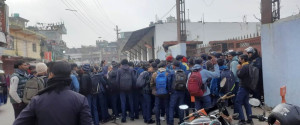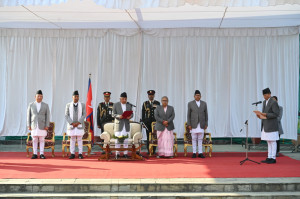National
Poor pass rate in entrance tests for medical courses exposes quality of education
Fewer students have qualified for many bachelor’s courses leaving many seats unfilled.
Binod Ghimire
Five student unions affiliated to the ruling alliance have asked the Medical Education Commission to re-conduct the entrance exams for medical and paramedical courses after fewer students than expected passed the tests leaving many of the available seats vacant.
The student unions said on Thursday that many students will be deprived of their rights to pursue the courses if the seats are left unfilled.
The commission had conducted entrance examinations for 16 different medical and paramedical programmes between July 24 and 28. The results published last week show the performance of a majority of the examinees was so poor that some of the medical education seats could not be filled up. In half of the courses, the number of eligible students is around half the seats available, although the number of examinees was several fold higher. The entrance examinations for each course carried a full mark of 200 and the examinee needed to secure at least 50 percent or 100 marks to pass. However, only a few dozen examinees were able to secure the 50 percent marks.
“The results were dismal. We need a serious discussion on the quality of education our students are getting,” Dr Shree Krishna Giri, vice-chairperson at the commission, told the Post. “It is unfortunate that hundreds of seats for medical and paramedical courses will be left unfulfilled this year.”
The commission, based on the infrastructural positions of the medical and other colleges, had in June determined the number of seats for the courses. Over 21,000 students had sat for the entrance examinations for the MBBS. As many as 4,319 students qualified for the 1,835 seats available at 22 medical colleges across the country. As the number of students who passed the entrance is more than twice the available seats, the students will get admissions on merit basis. But many seats available for several other programmes are likely to remain unfilled based on the entrance exams results.
While the commission had allocated 1,420 seats for the Bachelor’s in Public Health, only 565 students, or less than half the available seats, got through the entrance test. Similarly, for the Bachelor’s of Science (Nursing) only 504 examinees passed the entrance test although 1,100 seats are available for the course. And for Bachelor’s in Pharmacy, there are 902 seats available but only 547 students passed.
Likewise, out of the 150 seats meant for Bachelors in Physiotherapy, just 114 passed the entrance, and just 35 students met the eligibility criteria for the 71 seats available for Bachelor’s of Science in Medical Imaging Technology.
The pass rate was even worse for Bachelor’s of Science Medical Laboratory Technology. For the 425 seats available, only 118 students secured the pass marks.
Ranjeet Tamang, chairperson of the All Nepal National Independent Student Union (Revolutionary), a student wing of the ruling CPN (Maoist Centre), said they will pressure the government and the commission to re-conduct the entrance exams for the courses where the available seats remain unfilled.
“The pandemic has badly affected teaching-learning activities. That could be one of the reasons for the poor showing in the entrance tests,” he told the Post. “The commission should keep conducting entrance exams until all the available seats are filled.”
Successive governments in recent years have announced plans to promote technical and skills-based education.
The national budget for the current fiscal year says the government will give due focus to skills-oriented technical education to generate competent technical human resources.
However, the results of the recent entrance exams conducted by the Medical Education Commission shows the examinees lack a sound base for pursuing skills-based education, say the experts.
“The seats are being unfilled because students haven’t got 50 percent marks in the entrance exams. This is a serious issue,” Mana Kumari Rai, the president of the Nursing Association Nepal, who is a former professor at the Tribhuvan University Institute of Medicine, told the Post. “While we have to review the quality of education our students are getting, it is also necessary to go through the question papers set by the commission.”
She said unnecessarily tough questions might have led to the high rate of disqualification.
Giri, however, says the question papers were based on the grade 12 curriculum that tests the knowledge of the students in the courses they want to pursue. Students who have secured 50 percent marks in grade 12 are qualified to sit for the entrance test.
Education experts say the entrance tests reflect the weak teaching-learning environment and flawed evaluation process in grade 12 board exams.
The public- and community-run higher secondary schools don’t have permanent teacher positions while a majority of such schools lack subject teachers and this might have affected the academic performance of students, they say.
“We have to accept that the foundation of our students isn’t sound. The pandemic further dwindled the teaching-learning process,” Binay Kusiyait, a professor at Tribhuvan University, told the Post.
Operators of private colleges say the commission should conduct the entrance tests again to ensure that the available seats are filled.
Giri, the vice-chairperson, however, says they don’t have such a plan. The entrance tests that had to be conducted last year were held this year as the pandemic postponed the grade 12 examinations.
“We are planning to hold another test this year,” Giri told the Post. “However, we have no plan to conduct another entrance test to fill the seats.”




 5.17°C Kathmandu
5.17°C Kathmandu







%20(1).jpg&w=300&height=200)






